Multi-Perspective Analysis of Building Orientation Effects on Microstructure, Mechanical and Surface Properties of SLM Ti6Al4V with Specific Geometry
Abstract
:1. Introduction
2. Materials and Methods
2.1. Sample Preparation
2.2. Microstructure Observation
2.3. Measurement of Mechanical Properties, Residual Stresses and Surface Topography
3. Results and Discussion
3.1. Microstructure
3.2. EBSD Analysis
3.3. Densification
3.4. Residual Stress
3.5. Micro-Hardness
3.6. Tensile Properties
3.7. Surface Topography
4. Conclusions
- (1)
- In the SLM process, different building orientations resulted in different contact areas between the workpiece and the substrate, atmosphere and powder, which affected the heat conduction effect of the forming process. It led to different cooling rates (SLM-VB > SLM-PB-S > SLM-PB-L). The primary β phase was found in SLM-PB-S and SLM-PB-L, and the width of the primary β phase had the following size relationship: SLM-PB-S > SLM-PB-L. All the primary β phases grew along the building orientation.
- (2)
- The grain size, texture strength and two-phase distribution were greatly affected by the building orientation. High cooling rate was conducive to grain refinement and not conducive to the retention of β phase. The sample grain size relationship is as follows: SLM-VB < SLM-PB-S < SLM-PB-L. The texture strength relationship is as follows: SLM-PB-S > SLM-VB > SLM-PB-L. The ratio of β/α is as follows: SLM-PB-S > SLM-PB-L > SLM-VB.
- (3)
- The density, residual stress and surface roughness of the samples were also significantly affected by the building orientation. A high cooling rate led to insufficient melting of powder, resulting in high porosity, which led to a lower density. It also led to uneven plastic deformation, which in turn led to large residual stress. The density relationship of the obtained samples was: SLM-VB > SLM-PB-S > SLM-PB-L. In terms of residual stress, they are all tensile stress, and the size relationship was as follows: SLM-VB > SLM-PB-S > SLM-PB-L. The surface roughness was significantly affected by the forming method, heat transfer type and efficiency, and its value relationship was expressed as: SLM-VB < SLM-PB-S < SLM-PB-L.
- (4)
- With the change in building orientation, the mechanical properties such as microhardness, tensile strength and elongation of the materials also changed greatly. Smaller grain size, stronger texture, larger grain misorientations, smaller porosity and higher density are beneficial to the improvement of mechanical properties. In addition, a high proportion of β phase tends to improve the ductility of the material.
- (5)
- From conclusions (1) to (4), it was found that SLM-PB-S exhibited denser microstructure and better mechanical properties than SLM-PB-L. Therefore, the study on the different modes of horizontal building orientation is significant. The findings of this paper are helpful in selecting proper building orientation in the SLM process. For SLM Ti6Al4V samples, the shorter side in contact with the substrate is beneficial to obtain better mechanical properties when they are fabricated with horizontal building orientation.
Author Contributions
Funding
Institutional Review Board Statement
Informed Consent Statement
Data Availability Statement
Conflicts of Interest
References
- Karolewska, K.; Ligaj, B.; Wirwicki, M.; Szala, G. Strength analysis of Ti6Al4V titanium alloy produced by the use of additive manufacturing method under static load conditions. J. Mater. Res. Technol. 2020, 9, 1365–1379. [Google Scholar] [CrossRef]
- Wu, S.Q.; Lu, Y.J.; Gan, Y.L.; Huang, T.T.; Zhao, C.Q.; Lin, J.J.; Guo, S.; Lin, J.X. Microstructural evolution and microhardness of a selective-laser-melted Ti-6Al-4V alloy after post heat treatments. J. Alloy. Compd. 2016, 672, 643–652. [Google Scholar] [CrossRef]
- Barbieri, F.C.; Otani, C.; Lepienski, C.M.; Urruchi, W.I.; Maciel, H.S.; Petraconi, G. Nanoindentation study of Ti6Al4V alloy nitrided by low intensity plasma jet process. Vacuum 2002, 67, 457–461. [Google Scholar] [CrossRef]
- Huaixue, L.; Baiying, H.; Fan, S.; Shuili, G. Microstructure and Tensile Properties of Ti-6Al-4V Alloys Fabricated by Selective Laser Melting. Rare Met. Mater. Eng. 2013, 42, 209–212. [Google Scholar]
- Liu, S.; Shin, Y.C. Additive manufacturing of Ti6Al4V alloy: A review. Mater. Des. 2019, 164, 107552. [Google Scholar] [CrossRef]
- Wang, S.; Zhu, L.; Fuh, J.Y.H.; Zhang, H.; Yan, W. Multi-physics modeling and Gaussian process regression analysis of cladding track geometry for direct energy deposition. Opt. Lasers Eng. 2020, 127, 105950. [Google Scholar] [CrossRef]
- Chen, Z.; Wu, X.; Tomus, D.; Davies, C.H.J. Surface roughness of Selective Laser Melted Ti-6Al-4V alloy components. Addit. Manuf. 2018, 21, 91–103. [Google Scholar] [CrossRef]
- Cabanettes, F.; Joubert, A.; Chardon, G.; Dumas, V.; Rech, J.; Grosjean, C.; Dimkovski, Z. Topography of as built surfaces generated in metal additive manufacturing: A multi scale analysis from form to roughness. Precis. Eng. 2018, 52, 249–265. [Google Scholar] [CrossRef]
- Oyelola, O.; Crawforth, P.; M’Saoubi, R.; Clare, A.T. On the machinability of directed energy deposited Ti6Al4V. Addit. Manuf. 2018, 19, 39–50. [Google Scholar] [CrossRef]
- Zhou, L.; Mehta, A.; Schulz, E.; McWilliams, B.; Cho, K.; Sohn, Y. Microstructure, precipitates and hardness of selectively laser melted AlSi10Mg alloy before and after heat treatment. Mater. Charact. 2018, 143, 5–17. [Google Scholar] [CrossRef]
- Hadadzadeh, A.; Shalchi Amirkhiz, B.; Odeshi, A.; Li, J.; Mohammadi, M. Role of hierarchical microstructure of additively manufactured AlSi10Mg on dynamic loading behavior. Addit. Manuf. 2019, 28, 1–13. [Google Scholar] [CrossRef]
- Kan, W.H.; Nadot, Y.; Foley, M.; Ridosz, L.; Proust, G.; Cairney, J.M. Factors that affect the properties of additively-manufactured AlSi10Mg: Porosity versus microstructure. Addit. Manuf. 2019, 29, 100805. [Google Scholar] [CrossRef]
- Li, H.; Yang, Z.; Cai, D.; Jia, D.; Zhou, Y. Microstructure evolution and mechanical properties of selective laser melted bulk-form titanium matrix nanocomposites with minor B4C additions. Mater. Des. 2020, 185, 108245. [Google Scholar] [CrossRef]
- Han, Q.; Jiao, Y. Effect of heat treatment and laser surface remelting on AlSi10Mg alloy fabricated by selective laser melting. Int. J. Adv. Manuf. Technol. 2019, 102, 3315–3324. [Google Scholar] [CrossRef] [Green Version]
- Yan, X.; Yin, S.; Chen, C.; Huang, C.; Bolot, R.; Lupoi, R.; Kuang, M.; Ma, W.; Coddet, C.; Liao, H.; et al. Effect of heat treatment on the phase transformation and mechanical properties of Ti6Al4V fabricated by selective laser melting. J. Alloy. Compd. 2018, 764, 1056–1071. [Google Scholar] [CrossRef]
- Karami, K.; Blok, A.; Weber, L.; Ahmadi, S.M.; Petrov, R.; Nikolic, K.; Borisov, E.V.; Leeflang, S.; Ayas, C.; Zadpoor, A.A.; et al. Continuous and pulsed selective laser melting of Ti6Al4V lattice structures: Effect of post-processing on microstructural anisotropy and fatigue behaviour. Addit. Manuf. 2020, 36, 101433. [Google Scholar] [CrossRef]
- Xie, Z.; Dai, Y.; Ou, X.; Ni, S.; Song, M. Effects of selective laser melting build orientations on the microstructure and tensile performance of Ti–6Al–4V alloy. Mater. Sci. Eng. A 2020, 776, 139001. [Google Scholar] [CrossRef]
- Sun, D.; Gu, D.; Lin, K.; Ma, J.; Chen, W.; Huang, J.; Sun, X.; Chu, M. Selective laser melting of titanium parts: Influence of laser process parameters on macro- and microstructures and tensile property. Powder Technol. 2019, 342, 371–379. [Google Scholar] [CrossRef]
- Lee, H.Y.; Yi, S.M.; Lee, J.H.; Lee, H.S.; Hyun, S.; Joo, Y.C. Effects of bending fatigue on the electrical resistance in metallic films on flexible substrates. Met. Mater. Int. 2010, 16, 947–951. [Google Scholar] [CrossRef]
- Xia, M.; Gu, D.; Yu, G.; Dai, D.; Chen, H.; Shi, Q. Influence of hatch spacing on heat and mass transfer, thermodynamics and laser processability during additive manufacturing of Inconel 718 alloy. Int. J. Mach. Tools Manuf. 2016, 109, 147–157. [Google Scholar] [CrossRef]
- Qiu, C.; Panwisawas, C.; Ward, M.; Basoalto, H.C.; Brooks, J.W.; Attallah, M.M. On the role of melt flow into the surface structure and porosity development during selective laser melting. Acta Mater. 2015, 96, 72–79. [Google Scholar] [CrossRef] [Green Version]
- Song, J.; Wu, W.; Zhang, L.; He, B.; Lu, L.; Ni, X.; Long, Q.; Zhu, G. Role of scanning strategy on residual stress distribution in Ti-6Al-4V alloy prepared by selective laser melting. Optik 2018, 170, 342–352. [Google Scholar] [CrossRef]
- He, B.; Wu, W.; Zhang, L.; Lu, L.; Yang, Q.; Long, Q.; Chang, K. Microstructural characteristic and mechanical property of Ti6Al4V alloy fabricated by selective laser melting. Vacuum 2018, 150, 79–83. [Google Scholar] [CrossRef]
- Ren, S.; Chen, Y.; Liu, T.; Qu, X. Effect of Build Orientation on Mechanical Properties and Microstructure of Ti-6Al-4V Manufactured by Selective Laser Melting. Metall. Mater. Trans. A Phys. Metall. Mater. Sci. 2019, 50, 4388–4409. [Google Scholar] [CrossRef]
- Chang, K.; Liang, E.; Huang, W.; Zhang, X.; Chen, Y.; Dong, J.; Zhang, R. Microstructural feature and mechanical property in different building directions of additive manufactured Ti6Al4V alloy. Mater. Lett. 2020, 267, 127516. [Google Scholar] [CrossRef]
- Hu, Z.; Zhang, H.; Zhu, H.; Xiao, Z.; Nie, X.; Zeng, X. Microstructure, mechanical properties and strengthening mechanisms of AlCu5MnCdVA aluminum alloy fabricated by selective laser melting. Mater. Sci. Eng. A 2019, 759, 154–166. [Google Scholar] [CrossRef]
- Liu, J.; Song, Y.; Chen, C.; Wang, X.; Li, H.; Zhou, C.; Wang, J.; Guo, K.; Sun, J. Effect of scanning speed on the microstructure and mechanical behavior of 316L stainless steel fabricated by selective laser melting. Mater. Des. 2020, 186, 108355. [Google Scholar] [CrossRef]
- Oyelola, O.; Crawforth, P.; M’Saoubi, R.; Clare, A.T. Machining of functionally graded Ti6Al4V/ WC produced by directed energy deposition. Addit. Manuf. 2018, 24, 20–29. [Google Scholar] [CrossRef]
- Balbaa, M.; Mekhiel, S.; Elbestawi, M.; McIsaac, J. On selective laser melting of Inconel 718: Densification, surface roughness, and residual stresses. Mater. Des. 2020, 193, 108818. [Google Scholar] [CrossRef]
- Yang, J.; Yu, H.; Yin, J.; Gao, M.; Wang, Z.; Zeng, X. Formation and control of martensite in Ti-6Al-4V alloy produced by selective laser melting. Mater. Des. 2016, 108, 308–318. [Google Scholar] [CrossRef]
- Vrancken, B.; Thijs, L.; Kruth, J.P.; Van Humbeeck, J. Heat treatment of Ti6Al4V produced by Selective Laser Melting: Microstructure and mechanical properties. J. Alloy. Compd. 2012, 541, 177–185. [Google Scholar] [CrossRef] [Green Version]
- Bai, S.; Perevoshchikova, N.; Sha, Y.; Wu, X. The effects of selective laser melting process parameters on relative density of the AlSi10Mg parts and suitable procedures of the archimedes method. Appl. Sci. 2019, 9, 583. [Google Scholar] [CrossRef] [Green Version]
- Dong, L.X.; Wang, H.M. Microstructure and corrosion properties of laser-melted deposited Ti2Ni3Si/NiTi intermetallic alloy. J. Alloy. Compd. 2008, 465, 83–89. [Google Scholar] [CrossRef]
- Salmi, A.; Atzeni, E. History of residual stresses during the production phases of AlSi10Mg parts processed by powder bed additive manufacturing technology. Virtual Phys. Prototyp. 2017, 12, 153–160. [Google Scholar] [CrossRef]
- Kuo, C.N.; Chua, C.K.; Peng, P.C.; Chen, Y.W.; Sing, S.L.; Huang, S.; Su, Y.L. Microstructure evolution and mechanical property response via 3D printing parameter development of Al–Sc alloy. Virtual Phys. Prototyp. 2020, 15, 120–129. [Google Scholar] [CrossRef]
- Acevedo, R.; Sedlak, P.; Kolman, R.; Fredel, M. Residual stress analysis of additive manufacturing of metallic parts using ultrasonic waves: State of the art review. J. Mater. Res. Technol. 2020, 9, 9457–9477. [Google Scholar] [CrossRef]
- Salmi, A.; Atzeni, E. Residual stress analysis of thin AlSi10Mg parts produced by Laser Powder Bed Fusion. Virtual Phys. Prototyp. 2020, 15, 49–61. [Google Scholar] [CrossRef]
- Bartlett, J.L.; Li, X. An overview of residual stresses in metal powder bed fusion. Addit. Manuf. 2019, 27, 131–149. [Google Scholar] [CrossRef]
- Vishwakarma, J.; Chattopadhyay, K.; Santhi Srinivas, N.C. Effect of build orientation on microstructure and tensile behaviour of selectively laser melted M300 maraging steel. Mater. Sci. Eng. A 2020, 798, 140130. [Google Scholar] [CrossRef]
- Kaynak, Y.; Tascioglu, E. Post-processing effects on the surface characteristics of Inconel 718 alloy fabricated by selective laser melting additive manufacturing. Prog. Addit. Manuf. 2020, 5, 221–234. [Google Scholar] [CrossRef]
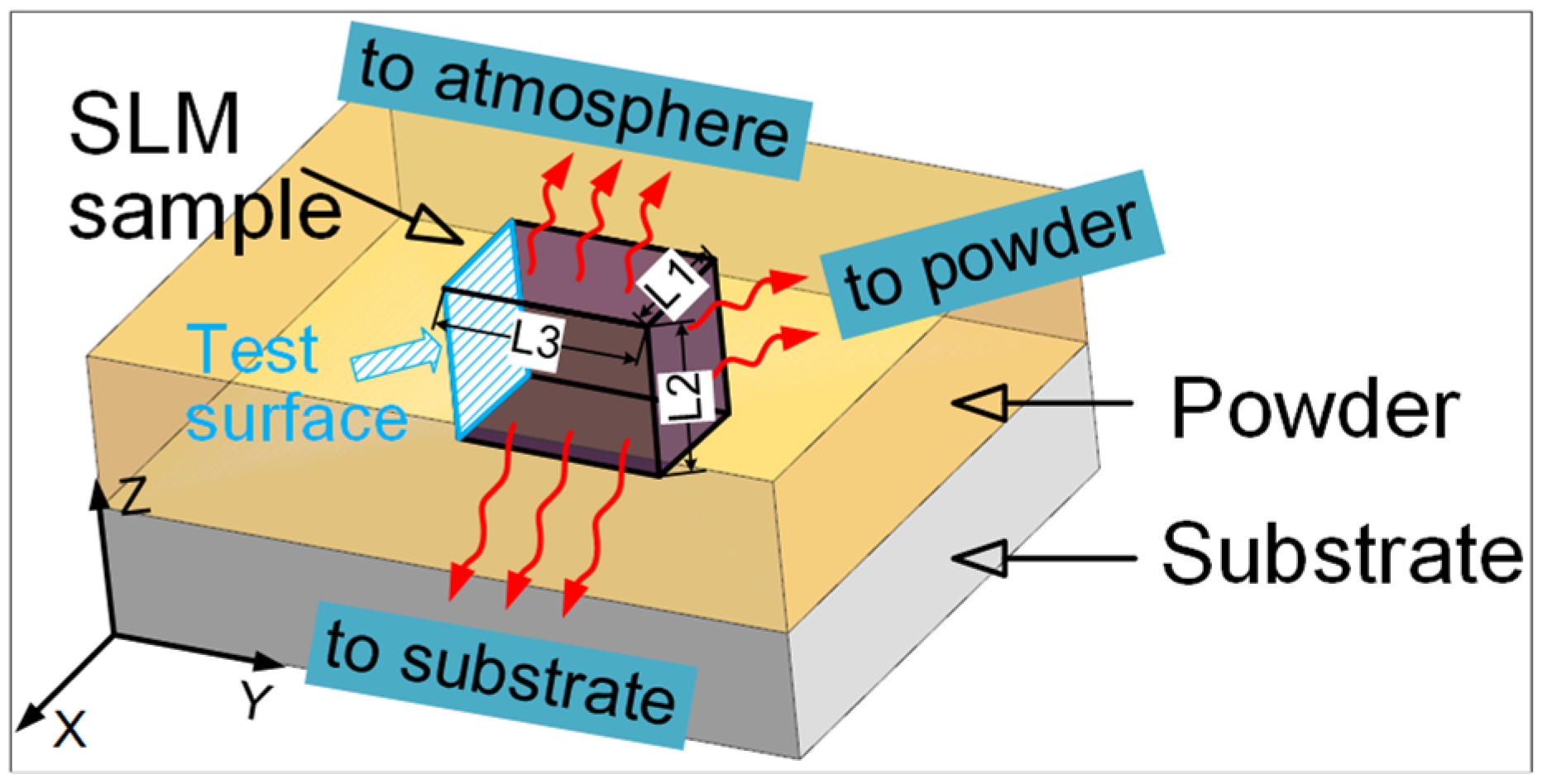
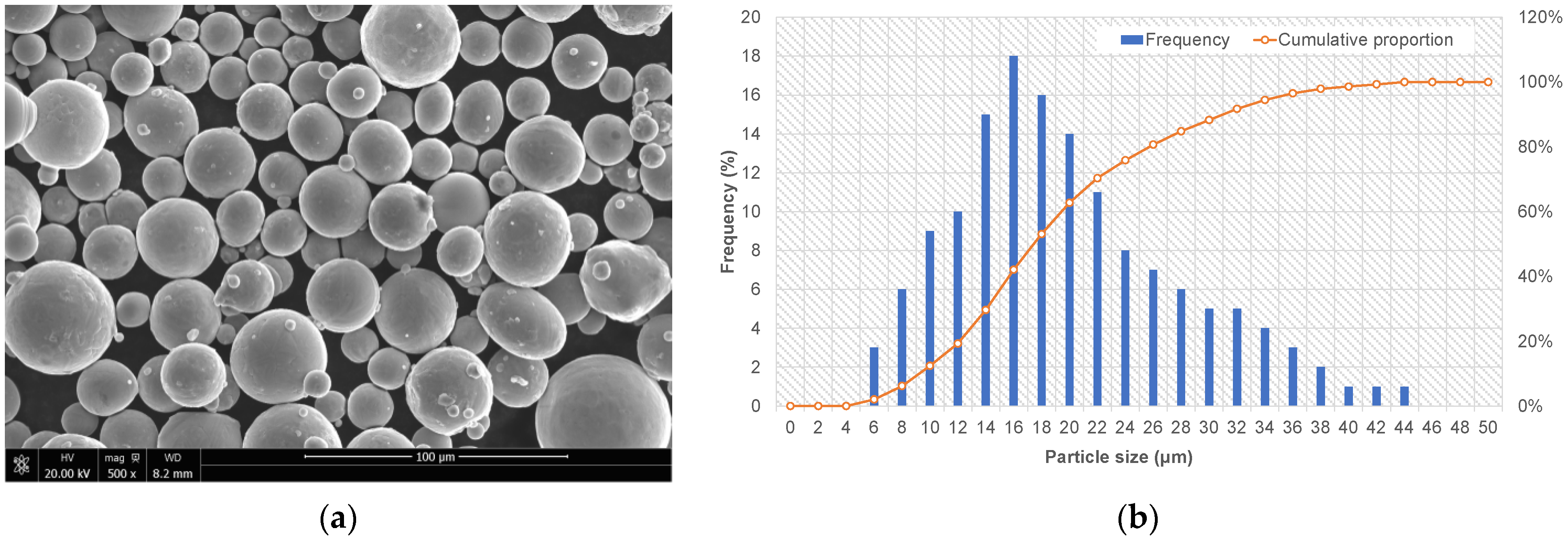

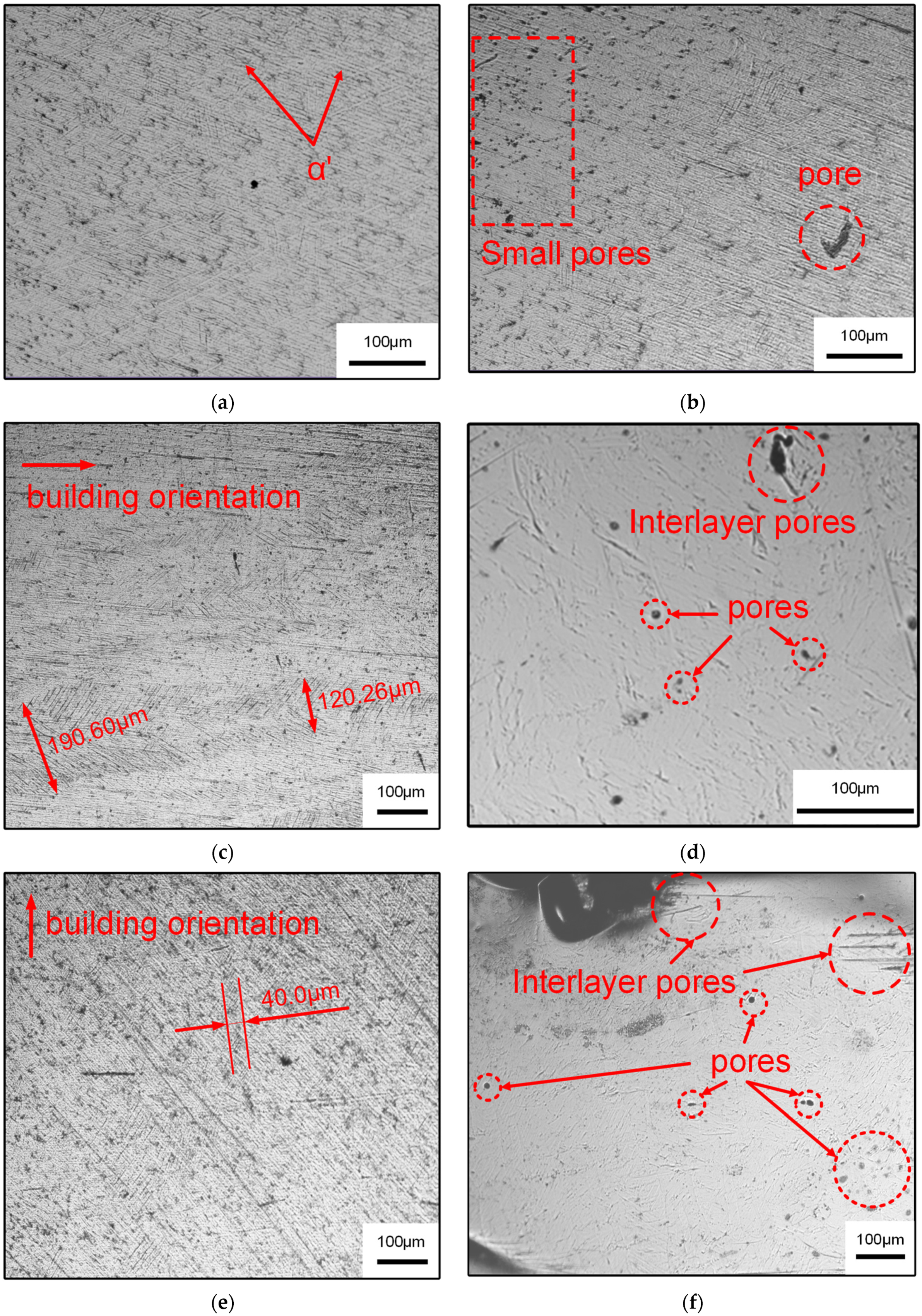
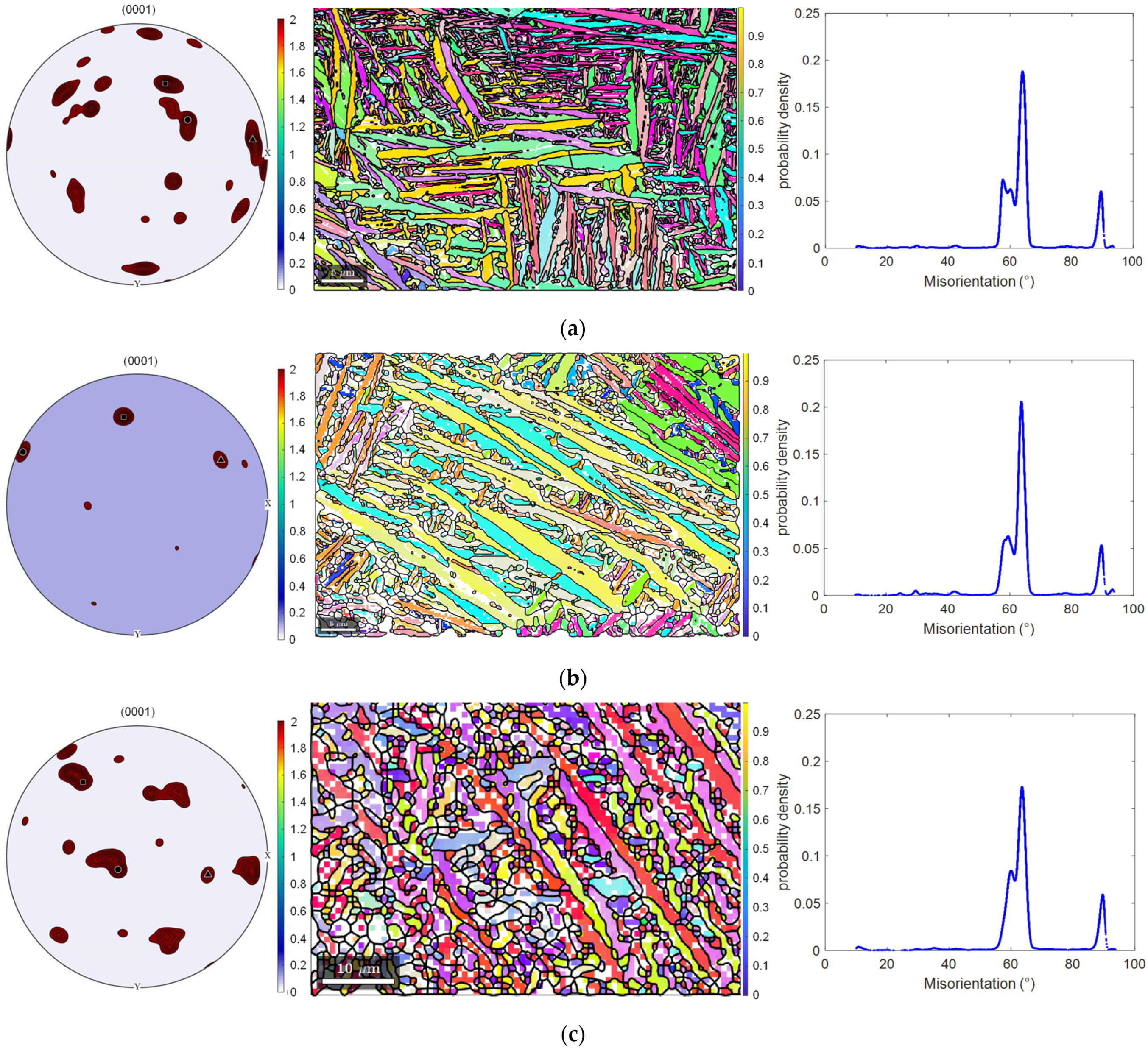
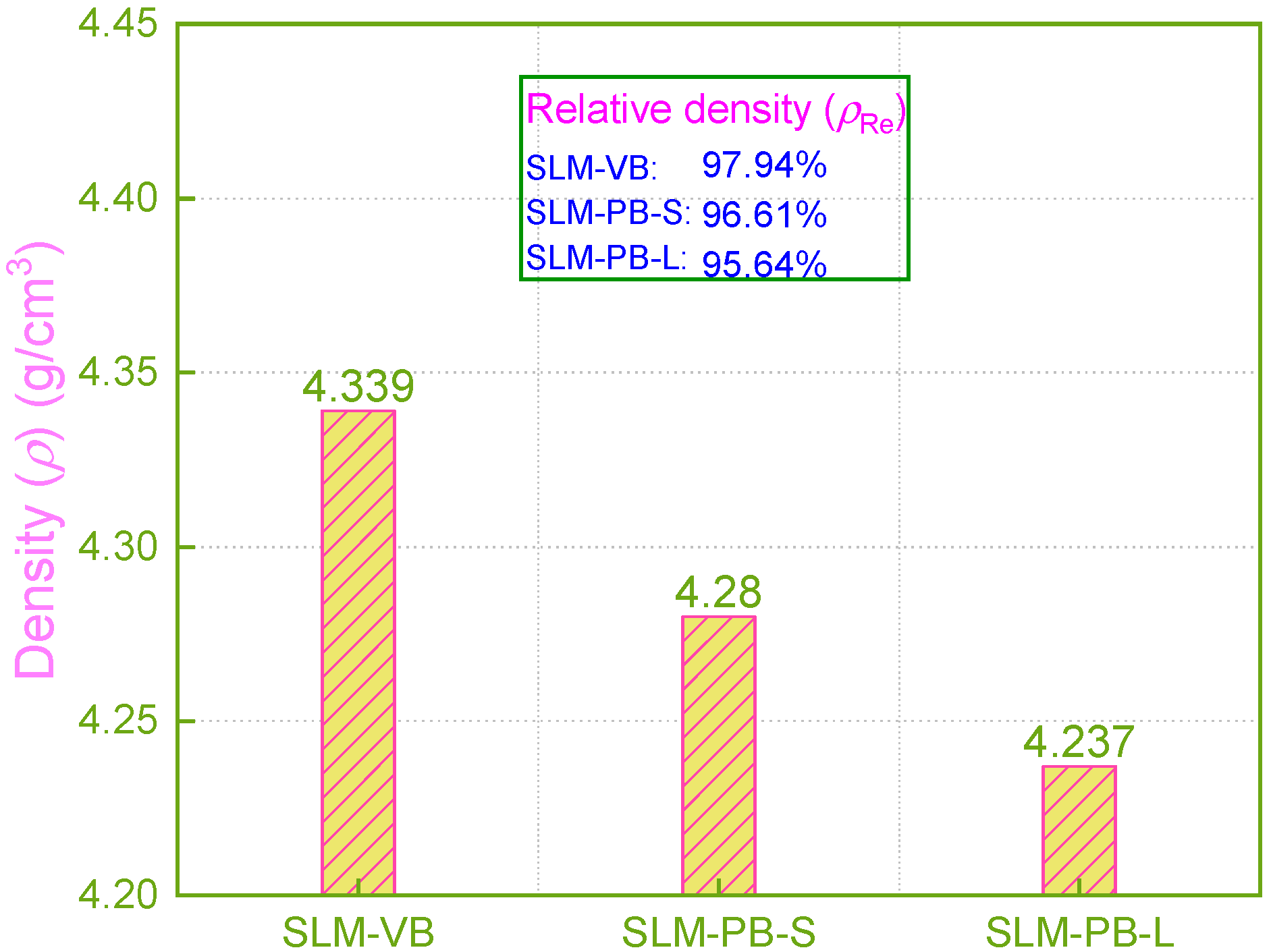
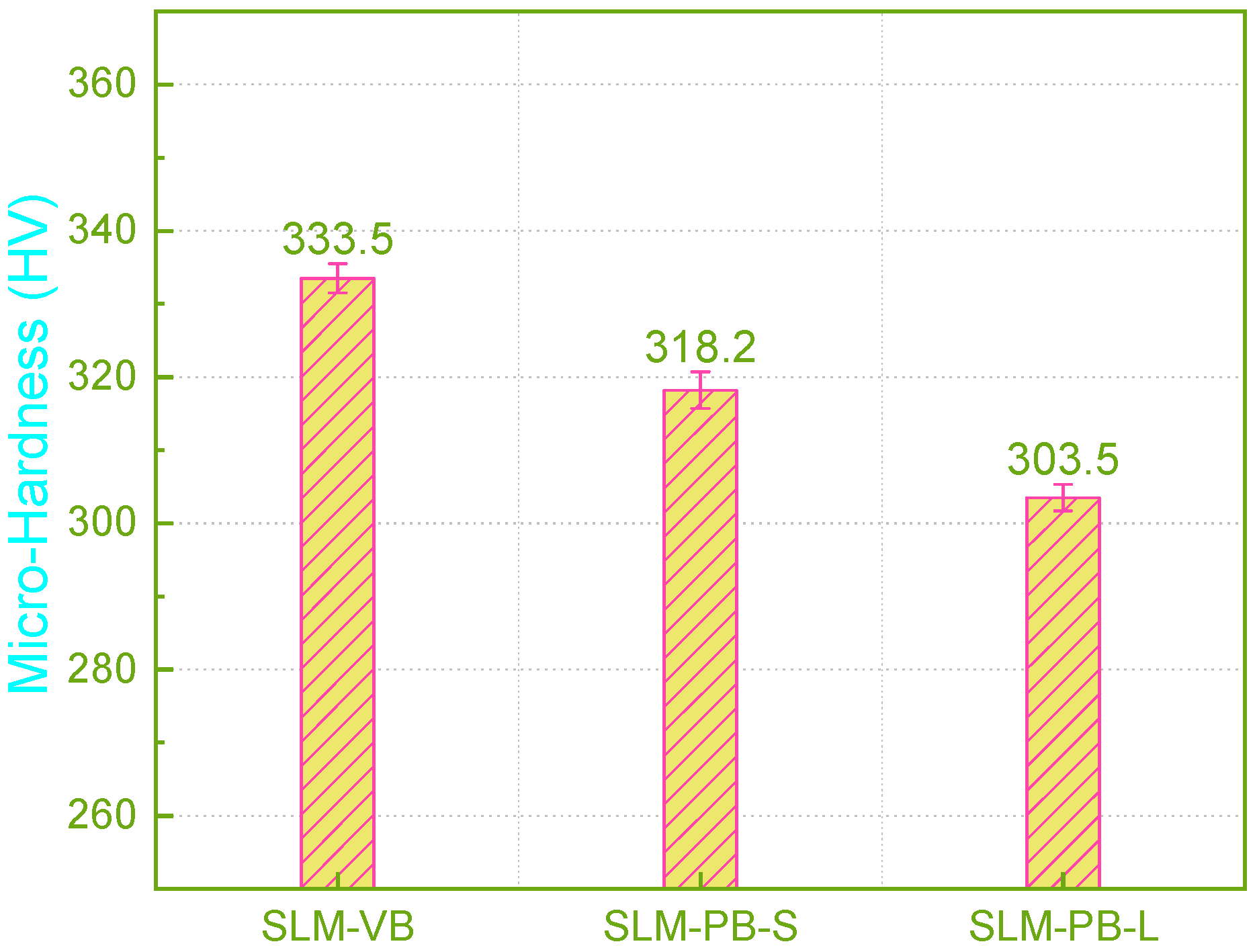
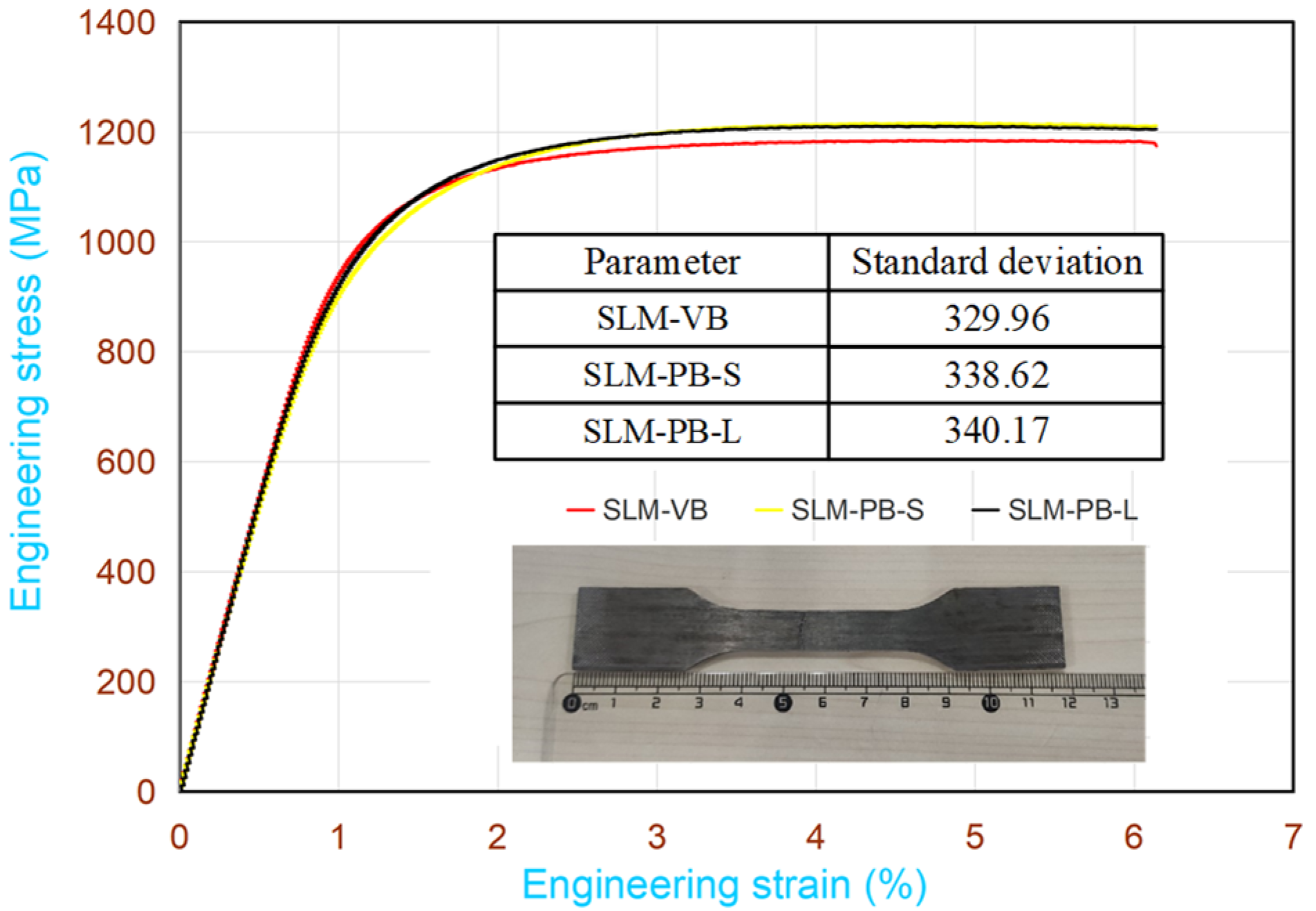
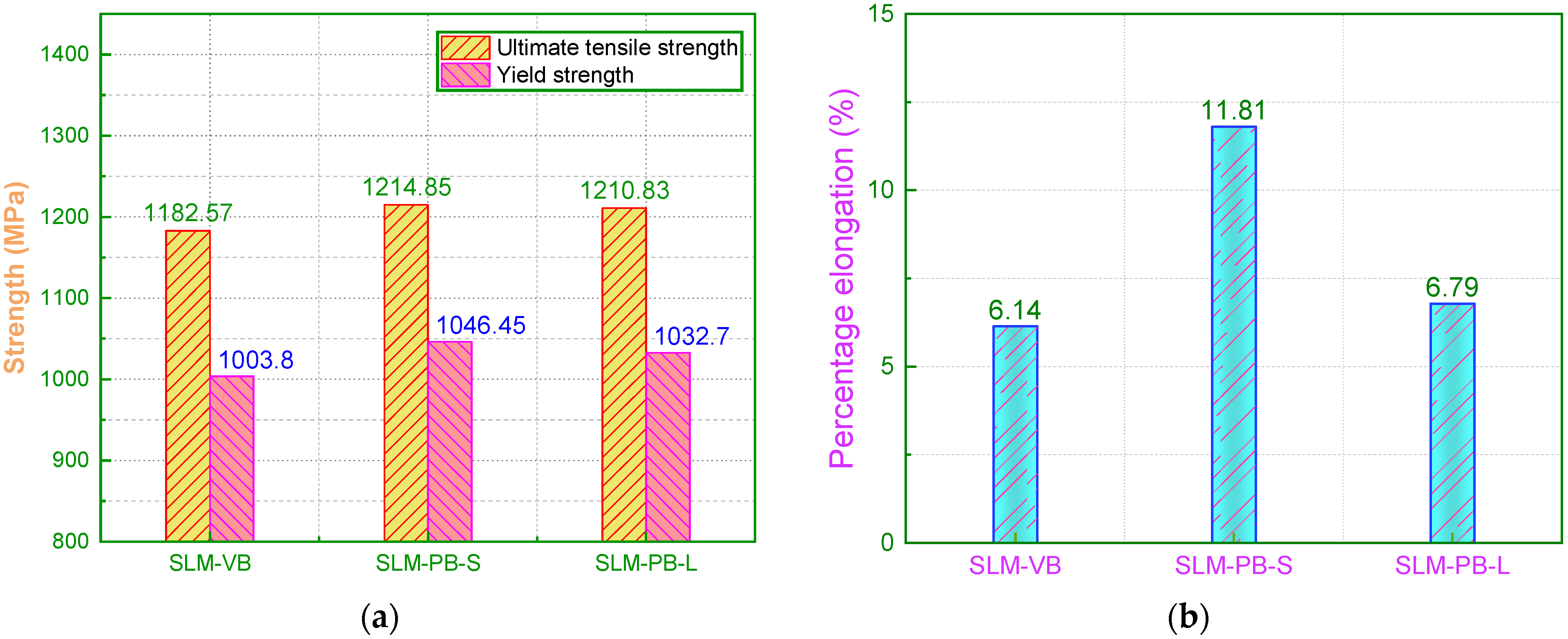
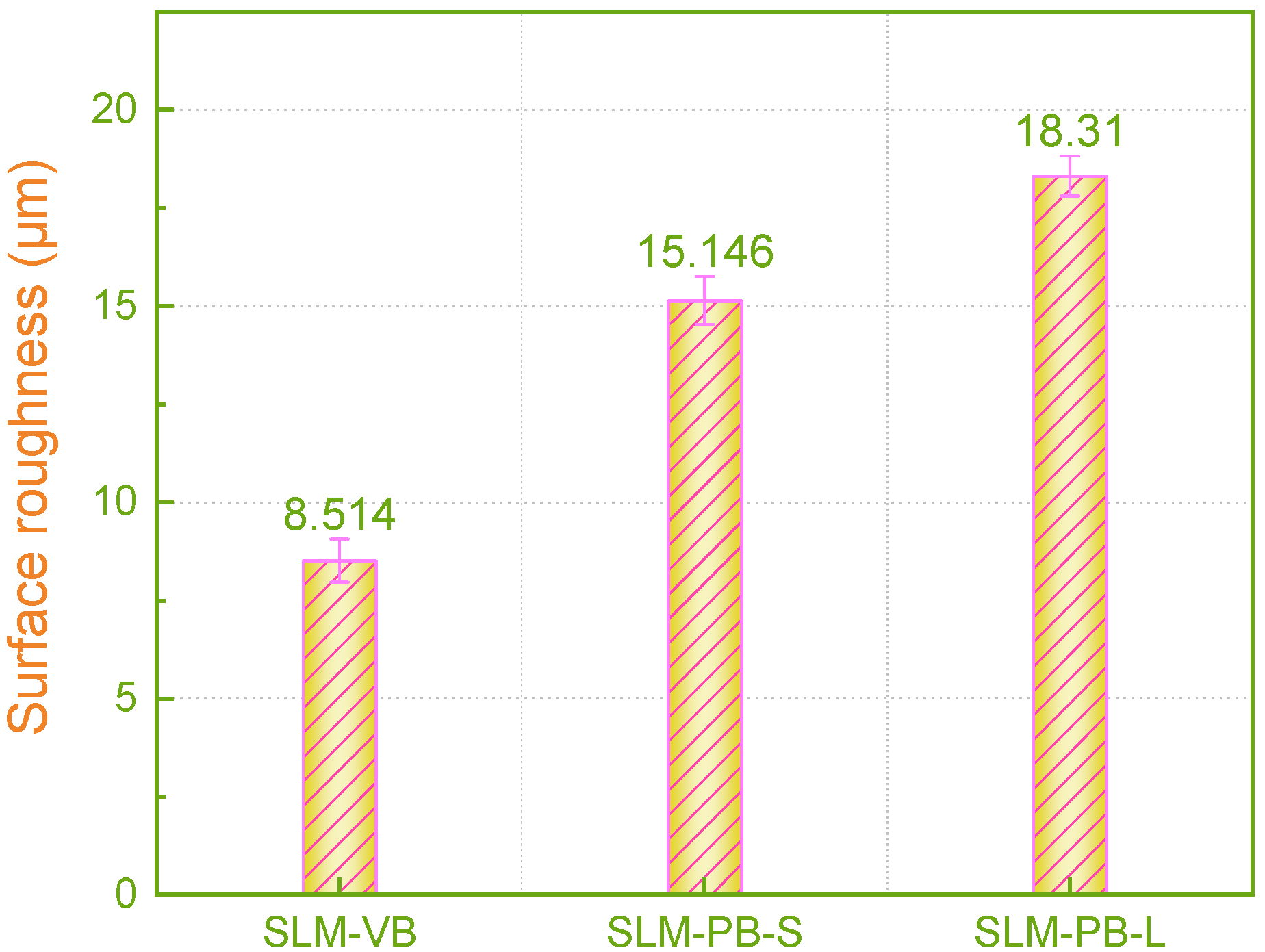
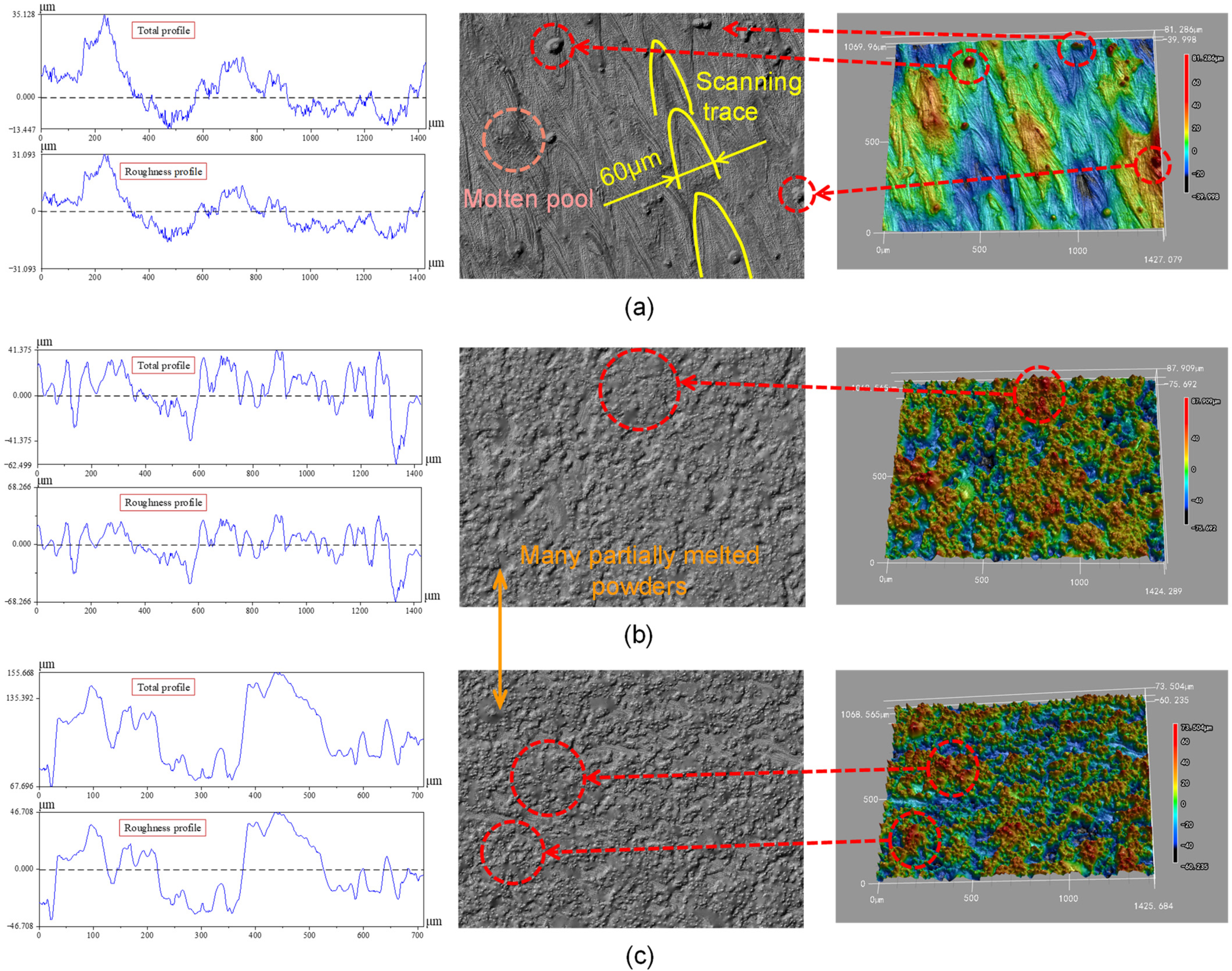
| Elements | Al | V | Fe | O | N | C | H | Ti |
|---|---|---|---|---|---|---|---|---|
| Content (Wt. %) | 5.5–6.5 | 3.5–4.5 | ≤0.25 | ≤0.13 | ≤0.03 | ≤0.08 | ≤0.012 | balance |
| Parameter | Value | Unit |
|---|---|---|
| Laser power/P | 145 | w |
| Scan speed/V | 1000 | mm/s |
| Hatch spacing/T | 82 | μm |
| Layer thickness/h | 30 | μm |
| Volume energy density/E | 58.94 | J/mm3 |
| Beam spot diameter/d | 60 | μm |
| Sr. No. | Surface | Mean Area (μm2) | Mean Aspect Ratio | Max Aspect Ratio |
|---|---|---|---|---|
| 1 | SLM-VB | 0.35 ± 0.03 | 3.49 ± 0.08 | 18.95 ± 0.56 |
| 2 | SLM-PB-S | 1.08 ± 0.05 | 3.20 ± 0.07 | 17.29 ± 0.32 |
| 3 | SLM-PB-L | 2.40 ± 0.06 | 2.66 ± 0.03 | 8.43 ± 0.16 |
| Sr. No. | Surface | VFPO (%) | Average Grain Size (μm) |
|---|---|---|---|
| 1 | SLM-VB | 21.4714 ± 0.0106 | 0.76 ± 0.07 |
| 2 | SLM-PB-S | 33.1181 ± 0.0235 | 1.30 ± 0.09 |
| 3 | SLM-PB-L | 20.2455 ± 0.0089 | 1.95 ± 0.18 |
| Sr. No | Surface | Volume Fraction-α (%) | Volume Fraction-β (%) | Volume Ratio (β/α) (%) |
|---|---|---|---|---|
| 1 | SLM-VB | 99.78 ± 0.04 | 0.22 ± 0.03 | 0.222 ± 0.029 |
| 2 | SLM-PB-S | 99.43 ± 0.01 | 0.57 ± 0.01 | 0.572 ± 0.011 |
| 3 | SLM-PB-L | 99.46 ± 0.02 | 0.54 ± 0.01 | 0.543 ± 0.010 |
| Sr. No | Test Surface | Residual Stress (MPa) |
|---|---|---|
| 1 | SLM-VB | 379.8 ± 89.2 |
| 2 | SLM-PB-S | 246.6 ± 31.6 |
| 3 | SLM-PB-L | 233.3 ± 67.6 |
Publisher’s Note: MDPI stays neutral with regard to jurisdictional claims in published maps and institutional affiliations. |
© 2021 by the authors. Licensee MDPI, Basel, Switzerland. This article is an open access article distributed under the terms and conditions of the Creative Commons Attribution (CC BY) license (https://creativecommons.org/licenses/by/4.0/).
Share and Cite
Cai, W.; Song, Q.; Ji, H.; Gupta, M.K. Multi-Perspective Analysis of Building Orientation Effects on Microstructure, Mechanical and Surface Properties of SLM Ti6Al4V with Specific Geometry. Materials 2021, 14, 4392. https://doi.org/10.3390/ma14164392
Cai W, Song Q, Ji H, Gupta MK. Multi-Perspective Analysis of Building Orientation Effects on Microstructure, Mechanical and Surface Properties of SLM Ti6Al4V with Specific Geometry. Materials. 2021; 14(16):4392. https://doi.org/10.3390/ma14164392
Chicago/Turabian StyleCai, Wentong, Qinghua Song, Hansong Ji, and Munish Kumar Gupta. 2021. "Multi-Perspective Analysis of Building Orientation Effects on Microstructure, Mechanical and Surface Properties of SLM Ti6Al4V with Specific Geometry" Materials 14, no. 16: 4392. https://doi.org/10.3390/ma14164392
APA StyleCai, W., Song, Q., Ji, H., & Gupta, M. K. (2021). Multi-Perspective Analysis of Building Orientation Effects on Microstructure, Mechanical and Surface Properties of SLM Ti6Al4V with Specific Geometry. Materials, 14(16), 4392. https://doi.org/10.3390/ma14164392








